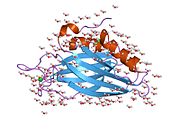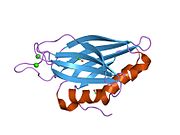SYT1
Synaptotagmin-1 is a protein that in humans is encoded by the SYT1 gene.[5]
Function
Synaptotagmins are integral membrane proteins of synaptic vesicles thought to serve as sensors for calcium ions (Ca2+) in the process of vesicular trafficking and exocytosis. Calcium ion binding to synaptotagmin I participates in triggering neurotransmitter release at the synapse (Fernandez-Chacon et al., 2001). [Supplied by OMIM][6]
SYT1 is the master switch responsible for allowing the human brain to release neurotransmitters. SYT1 senses calcium ion concentrations as low as 10 ppm and subsequently signals the SNARE complex to open fusion pores.[7]
Interactions
SYT1 has been shown to interact with SNAP-25,[8][9] STX1A[10][11] and S100A13.[12][13]
Clinical Significance
Mutations in the SYT1 gene cause a rare neurodevelopmental disorder known as SYT1-associated neurodevelopmental disorder (or Baker-Gordon Syndrome).[14][15]
References
- ^ a b c GRCh38: Ensembl release 89: ENSG00000067715 – Ensembl, May 2017
- ^ a b c GRCm38: Ensembl release 89: ENSMUSG00000035864 – Ensembl, May 2017
- ^ "Human PubMed Reference:". National Center for Biotechnology Information, U.S. National Library of Medicine.
- ^ "Mouse PubMed Reference:". National Center for Biotechnology Information, U.S. National Library of Medicine.
- ^ Perin MS, Johnston PA, Ozcelik T, Jahn R, Francke U, Südhof TC (Jan 1991). "Structural and functional conservation of synaptotagmin (p65) in Drosophila and humans". The Journal of Biological Chemistry. 266 (1): 615–22. PMID 1840599.
- ^ "Entrez Gene: SYT1 synaptotagmin I".
- ^ Lee HK, Yang Y, Su Z, Hyeon C, Lee TS, Lee HW, Kweon DH, Shin YK, Yoon TY (May 2010). "Dynamic Ca2+-dependent stimulation of vesicle fusion by membrane-anchored synaptotagmin 1". Science. 328 (5979): 760–3. doi:10.1126/science.1187722. PMC 2994549. PMID 20448186.
{{cite journal}}: Unknown parameter|lay-source=ignored (help); Unknown parameter|lay-url=ignored (help) - ^ Gerona RR, Larsen EC, Kowalchyk JA, Martin TF (Mar 2000). "The C terminus of SNAP25 is essential for Ca(2+)-dependent binding of synaptotagmin to SNARE complexes". The Journal of Biological Chemistry. 275 (9): 6328–36. doi:10.1074/jbc.275.9.6328. PMID 10692432.
- ^ Zhang X, Kim-Miller MJ, Fukuda M, Kowalchyk JA, Martin TF (May 2002). "Ca2+-dependent synaptotagmin binding to SNAP-25 is essential for Ca2+-triggered exocytosis". Neuron. 34 (4): 599–611. doi:10.1016/S0896-6273(02)00671-2. PMID 12062043. S2CID 16768299.
- ^ Shao X, Li C, Fernandez I, Zhang X, Südhof TC, Rizo J (Jan 1997). "Synaptotagmin-syntaxin interaction: the C2 domain as a Ca2+-dependent electrostatic switch". Neuron. 18 (1): 133–42. doi:10.1016/S0896-6273(01)80052-0. PMID 9010211. S2CID 17947552.
- ^ Thomas DM, Ferguson GD, Herschman HR, Elferink LA (Jul 1999). "Functional and biochemical analysis of the C2 domains of synaptotagmin IV". Molecular Biology of the Cell. 10 (7): 2285–95. doi:10.1091/mbc.10.7.2285. PMC 25443. PMID 10397765.
- ^ Mouta Carreira C, LaVallee TM, Tarantini F, Jackson A, Lathrop JT, Hampton B, Burgess WH, Maciag T (Aug 1998). "S100A13 is involved in the regulation of fibroblast growth factor-1 and p40 synaptotagmin-1 release in vitro". The Journal of Biological Chemistry. 273 (35): 22224–31. doi:10.1074/jbc.273.35.22224. PMID 9712836.
- ^ Landriscina M, Bagalá C, Mandinova A, Soldi R, Micucci I, Bellum S, Prudovsky I, Maciag T (Jul 2001). "Copper induces the assembly of a multiprotein aggregate implicated in the release of fibroblast growth factor 1 in response to stress". The Journal of Biological Chemistry. 276 (27): 25549–57. doi:10.1074/jbc.M102925200. PMID 11432880.
- ^ Baker K, Gordon SL, Melland H, et al. (2018). "SYT1-associated neurodevelopmental disorder: a case series". Brain. 141 (9): 2576–2591. doi:10.1093/brain/awy209. PMC 6113648. PMID 30107533.
- ^ "OMIM entry: Baker-Gordon Syndrome".
Further reading
- Mochly-Rosen D, Miller KG, Scheller RH, Khaner H, Lopez J, Smith BL (Sep 1992). "p65 fragments, homologous to the C2 region of protein kinase C, bind to the intracellular receptors for protein kinase C". Biochemistry. 31 (35): 8120–4. doi:10.1021/bi00150a003. PMID 1326322.
- McMahon HT, Missler M, Li C, Südhof TC (Oct 1995). "Complexins: cytosolic proteins that regulate SNAP receptor function". Cell. 83 (1): 111–9. doi:10.1016/0092-8674(95)90239-2. PMID 7553862. S2CID 675343.
- O'Regan S, Diebler MF, Meunier FM, Vyas S (Jan 1995). "A Ewing's sarcoma cell line showing some, but not all, of the traits of a cholinergic neuron". Journal of Neurochemistry. 64 (1): 69–76. doi:10.1046/j.1471-4159.1995.64010069.x. PMID 7798952. S2CID 20958851.
- Zhang JZ, Davletov BA, Südhof TC, Anderson RG (Sep 1994). "Synaptotagmin I is a high affinity receptor for clathrin AP-2: implications for membrane recycling". Cell. 78 (5): 751–60. doi:10.1016/S0092-8674(94)90442-1. PMID 8087843. S2CID 44550431.
- Chapman ER, Blasi J, An S, Brose N, Johnston PA, Südhof TC, Jahn R (Aug 1996). "Fatty acylation of synaptotagmin in PC12 cells and synaptosomes". Biochemical and Biophysical Research Communications. 225 (1): 326–32. doi:10.1006/bbrc.1996.1174. PMID 8769138.
- Perin MS (Oct 1996). "Mirror image motifs mediate the interaction of the COOH terminus of multiple synaptotagmins with the neurexins and calmodulin". Biochemistry. 35 (43): 13808–16. doi:10.1021/bi960853x. PMID 8901523.
- Betz A, Okamoto M, Benseler F, Brose N (Jan 1997). "Direct interaction of the rat unc-13 homologue Munc13-1 with the N terminus of syntaxin". The Journal of Biological Chemistry. 272 (4): 2520–6. doi:10.1074/jbc.272.4.2520. PMID 8999968.
- Shao X, Li C, Fernandez I, Zhang X, Südhof TC, Rizo J (Jan 1997). "Synaptotagmin-syntaxin interaction: the C2 domain as a Ca2+-dependent electrostatic switch". Neuron. 18 (1): 133–42. doi:10.1016/S0896-6273(01)80052-0. PMID 9010211. S2CID 17947552.
- Charvin N, L'evêque C, Walker D, Berton F, Raymond C, Kataoka M, Shoji-Kasai Y, Takahashi M, De Waard M, Seagar MJ (Aug 1997). "Direct interaction of the calcium sensor protein synaptotagmin I with a cytoplasmic domain of the alpha1A subunit of the P/Q-type calcium channel". The EMBO Journal. 16 (15): 4591–6. doi:10.1093/emboj/16.15.4591. PMC 1170085. PMID 9303303.
- Mouta Carreira C, LaVallee TM, Tarantini F, Jackson A, Lathrop JT, Hampton B, Burgess WH, Maciag T (Aug 1998). "S100A13 is involved in the regulation of fibroblast growth factor-1 and p40 synaptotagmin-1 release in vitro". The Journal of Biological Chemistry. 273 (35): 22224–31. doi:10.1074/jbc.273.35.22224. PMID 9712836.
- Thomas DM, Ferguson GD, Herschman HR, Elferink LA (Jul 1999). "Functional and biochemical analysis of the C2 domains of synaptotagmin IV". Molecular Biology of the Cell. 10 (7): 2285–95. doi:10.1091/mbc.10.7.2285. PMC 25443. PMID 10397765.
- Gerona RR, Larsen EC, Kowalchyk JA, Martin TF (Mar 2000). "The C terminus of SNAP25 is essential for Ca(2+)-dependent binding of synaptotagmin to SNARE complexes". The Journal of Biological Chemistry. 275 (9): 6328–36. doi:10.1074/jbc.275.9.6328. PMID 10692432.
- Mizutani A, Fukuda M, Ibata K, Shiraishi Y, Mikoshiba K (Mar 2000). "SYNCRIP, a cytoplasmic counterpart of heterogeneous nuclear ribonucleoprotein R, interacts with ubiquitous synaptotagmin isoforms". The Journal of Biological Chemistry. 275 (13): 9823–31. doi:10.1074/jbc.275.13.9823. PMID 10734137.
- Kimura N, Shiraishi S, Mizunashi K, Ohtsu H, Kimura I (Mar 2001). "Synaptotagmin I expression in mast cells of normal human tissues, systemic mast cell disease, and a human mast cell leukemia cell line". The Journal of Histochemistry and Cytochemistry. 49 (3): 341–6. doi:10.1177/002215540104900308. PMID 11181737.
- Fernández-Chacón R, Königstorfer A, Gerber SH, García J, Matos MF, Stevens CF, Brose N, Rizo J, Rosenmund C, Südhof TC (Mar 2001). "Synaptotagmin I functions as a calcium regulator of release probability". Nature. 410 (6824): 41–9. doi:10.1038/35065004. PMID 11242035. S2CID 1756258.
- Fukuda M, Mikoshiba K (Mar 2001). "Synaptotagmin-like protein 1-3: a novel family of C-terminal-type tandem C2 proteins". Biochemical and Biophysical Research Communications. 281 (5): 1226–33. doi:10.1006/bbrc.2001.4512. PMID 11243866.
- Martina JA, Bonangelino CJ, Aguilar RC, Bonifacino JS (May 2001). "Stonin 2: an adaptor-like protein that interacts with components of the endocytic machinery". The Journal of Cell Biology. 153 (5): 1111–20. doi:10.1083/jcb.153.5.1111. PMC 2174325. PMID 11381094.
- Landriscina M, Bagalá C, Mandinova A, Soldi R, Micucci I, Bellum S, Prudovsky I, Maciag T (Jul 2001). "Copper induces the assembly of a multiprotein aggregate implicated in the release of fibroblast growth factor 1 in response to stress". The Journal of Biological Chemistry. 276 (27): 25549–57. doi:10.1074/jbc.M102925200. PMID 11432880.
- Coppola T, Magnin-Luthi S, Perret-Menoud V, Gattesco S, Schiavo G, Regazzi R (Aug 2001). "Direct interaction of the Rab3 effector RIM with Ca2+ channels, SNAP-25, and synaptotagmin". The Journal of Biological Chemistry. 276 (35): 32756–62. doi:10.1074/jbc.M100929200. PMID 11438518.














